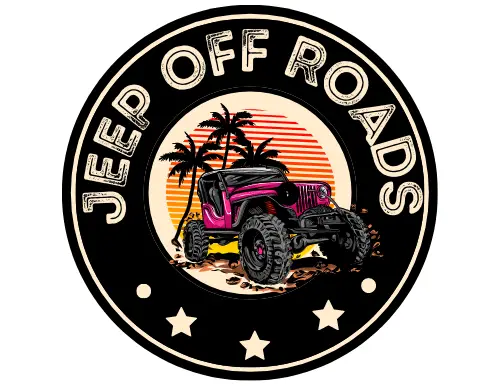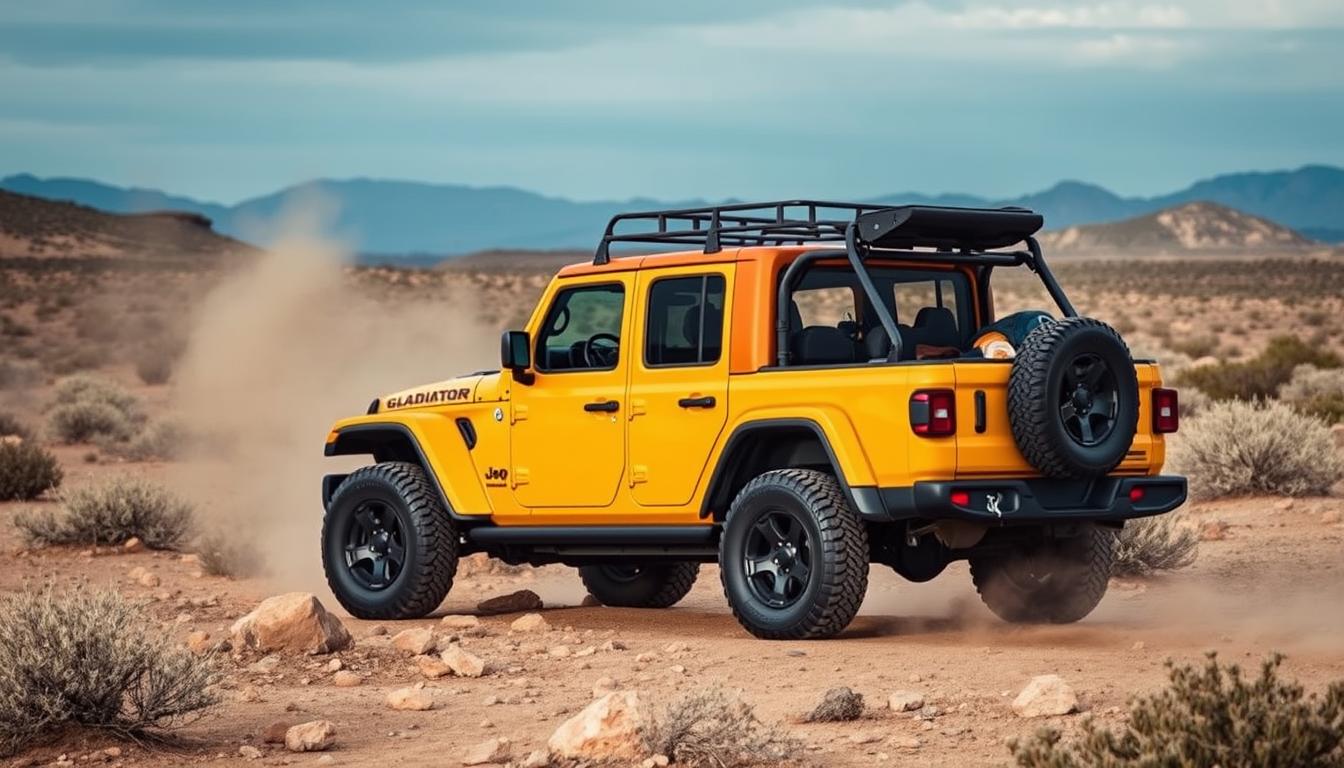The Jeep Gladiator is a unique truck that combines off-road skills with on-road comfort. Yet, it has its downsides. Issues like limited fuel efficiency and a high purchase price are notable. These jeep gladiator cons are important for potential buyers to know.
Concerns about the Jeep Gladiator include its small bed size and poor fuel economy. Its high weight also leads to high gas consumption. Some customers have complained about the interior rattling and the truck’s height being hard to step up into for those under 6 feet tall. These issues can impact the vehicle’s comfort and practicality.
For those considering a Jeep Gladiator, it’s key to think about the potential drawbacks. These include limited interior space, noise in the cabin, and towing capacity issues. Knowing these jeep gladiator issues helps buyers decide if it’s the right fit for them.
Key Takeaways
- The Jeep Gladiator has limited fuel efficiency, with an EPA-estimated 17 miles per gallon (mpg) city and 22 mpg highway.
- The vehicle has a high purchase price, with a base price starting at $34,040 and a destination charge of $1,495.
- The Jeep Gladiator has a small bed size, which can make it challenging to haul bulky items.
- The vehicle’s weight can contribute to high gas consumption, and customer complaints note that the interior can rattle.
- Understanding the issues with jeep gladiator is crucial for making an informed decision and determining if the vehicle is right for your needs.
- Exploring the jeep gladiator cons, including interior space limitations and noise levels in the cabin, can help buyers make a more informed decision.
- Considering the what are the negatives of a jeep gladiator can help buyers weigh the pros and cons of the vehicle and determine if it is the right choice for them.
Limited Fuel Efficiency
The Jeep Gladiator’s fuel efficiency is a big worry for those looking to buy it. The EPA says it gets 17 miles per gallon in the city, 22 on the highway, and 19 combined. This is because it’s heavy and has a big engine, which uses more fuel.
Many see the Gladiator’s poor fuel economy as a major problem. It costs more to fill up over time. Compared to other cars, the Gladiator uses more gas, which is a big drawback. Many owners say they get less gas mileage than expected when driving.
Here are some key statistics to consider:
- EPA-estimated fuel economy: 17 mpg city, 22 mpg highway, 19 mpg combined
- Engine displacement: 3.6-Liter V6
- Horsepower output: 285 horsepower
- Towing capacity: 4,500 pounds
The Jeep Gladiator’s fuel efficiency is a big issue for buyers. It’s not the most fuel-efficient car out there. But, it has great off-road skills and can tow a lot, which might appeal to some.
High Purchase Price
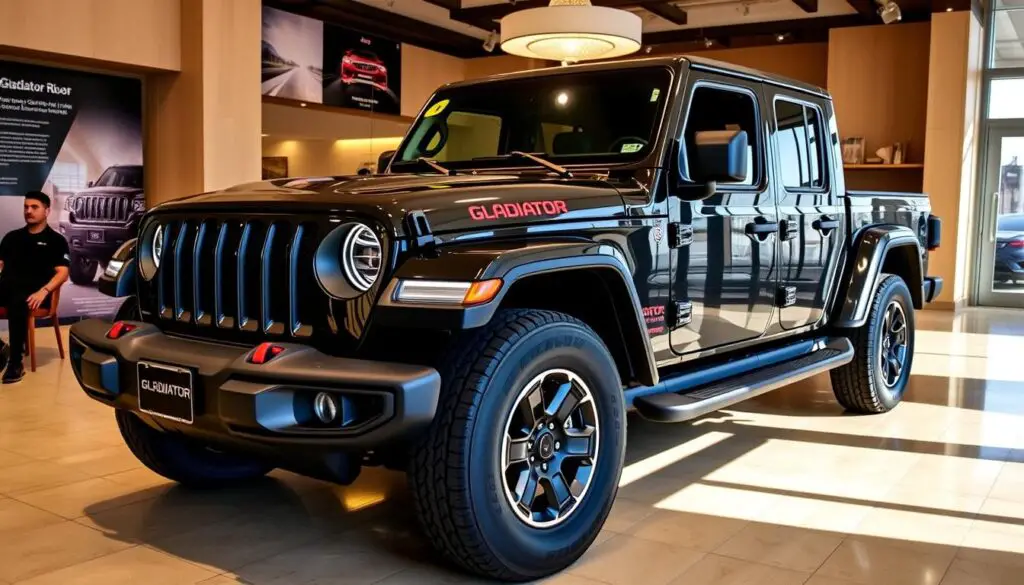
The Jeep Gladiator comes with many features, but its high price is a big drawback. It starts at $37,895 for the base model. As you go up in trim levels, the price goes up too. The Gladiator Sport S starts at $41,395, and the Willys at $44,995.
The Rubicon and Mojave trims are even pricier, starting at $52,995. The Rubicon X and Mojave X trims cost $62,995. Special editions like the Texas Trail and Beach start at $48,090 and $51,035. These prices can be a big issue for those on a tight budget.
Here are some key features and prices of the different trim levels:
- Gladiator Sport S: $41,395
- Gladiator Willys: $44,995
- Gladiator Rubicon and Mojave: $52,995
- Gladiator Rubicon X and Mojave X: $62,995
- Texas Trail special edition: $48,090
- Beach special edition: $51,035
When thinking about buying a Jeep Gladiator, it’s important to consider the costs. Look at the jeep gladiator cons and drawbacks. This will help you make a well-informed decision.
| Trim Level | Price |
|---|---|
| Gladiator Sport S | $41,395 |
| Gladiator Willys | $44,995 |
| Gladiator Rubicon and Mojave | $52,995 |
| Gladiator Rubicon X and Mojave X | $62,995 |
Ride Quality Concerns
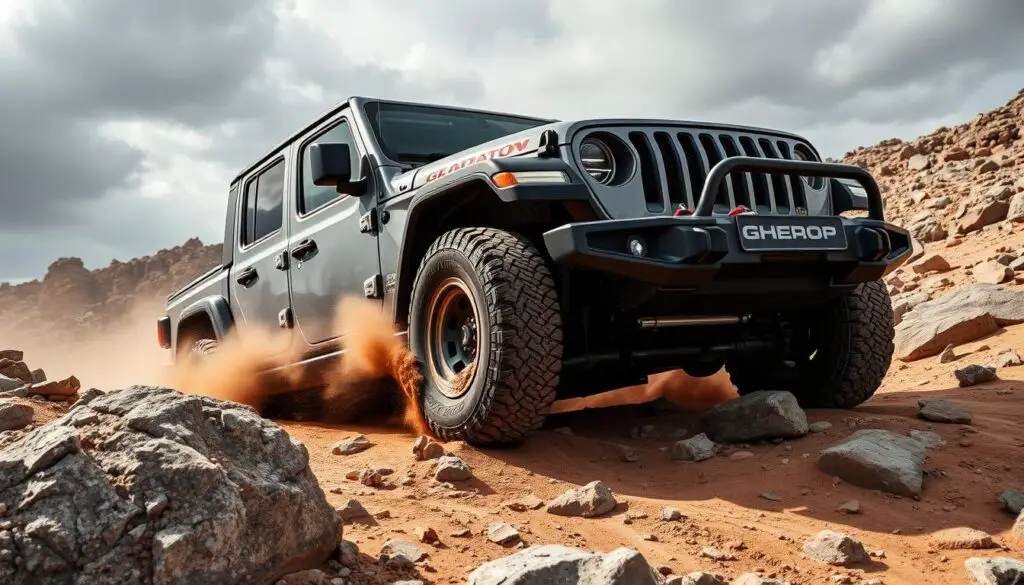
The Jeep Gladiator is great for off-roading, but it might not be as smooth on paved roads. Some owners find the ride rough, which is a big jeep gladiator disadvantage. This is because it focuses more on off-road skills than on being comfortable like regular pickup trucks.
The rear suspension shocks are another issue. They can feel too soft, causing the truck to bounce a lot at high speeds. This is a big problem for those who drive a lot, as it makes the ride uncomfortable and less safe.
Even with these jeep gladiator downsides, many off-road fans still love the Gladiator. But, if you value a smooth ride more, you might want to look at other options. Here are some important things to think about:
- Rear suspension shocks can feel under-valved
- Ride quality can be rough on paved roads
- Off-road capability can come at the expense of comfort
The Jeep Gladiator is made for those who love off-roading. Its rough ride is a trade-off for its amazing off-road skills. It’s not for everyone, but it’s a great choice for those who need a tough vehicle for off-road adventures.
| Vehicle | Ride Quality | Off-Road Capability |
|---|---|---|
| Jeep Gladiator | Rough on paved roads | Exceptional |
| Standard Pickup Trucks | Generally comfortable | Varies |
Interior Space Limitations
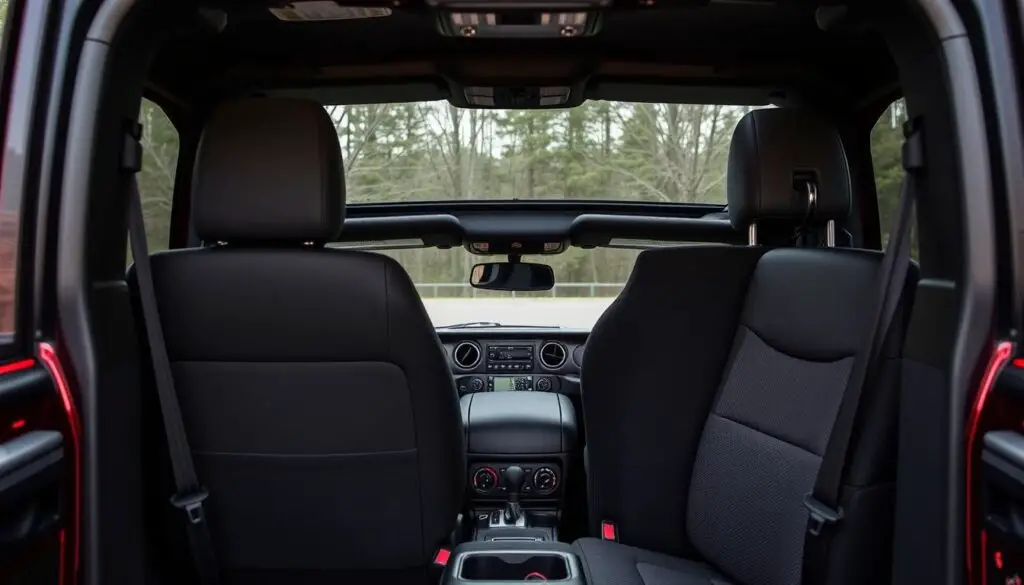
The Jeep Gladiator has some downsides, like limited interior space. This can be a big problem for some owners. The rear seat space is cramped, and the cargo area is small, making it hard to carry big items.
The interior design focuses more on the front seats than the back. The front seats are comfy and roomy, but the rear seats are tight and less comfy. This is a big issue for families or groups who travel together. The cargo space is also small, with a max of about 35 cubic feet.
Despite these issues, the Jeep Gladiator has some good points. It has a unique interior design and lots of features that make driving easy and fun. But, if you need lots of space inside, the Gladiator might not be the best pick. It’s important to think about the pros and cons before deciding.
Here are some key interior features of the Jeep Gladiator:
- Comfortable front seats with plenty of legroom and headroom
- Smaller rear seats with less legroom and headroom
- Limited cargo capacity, with a max of about 35 cubic feet
- Unique interior design with features like a touchscreen infotainment system and storage spots
Noise Levels in the Cabin
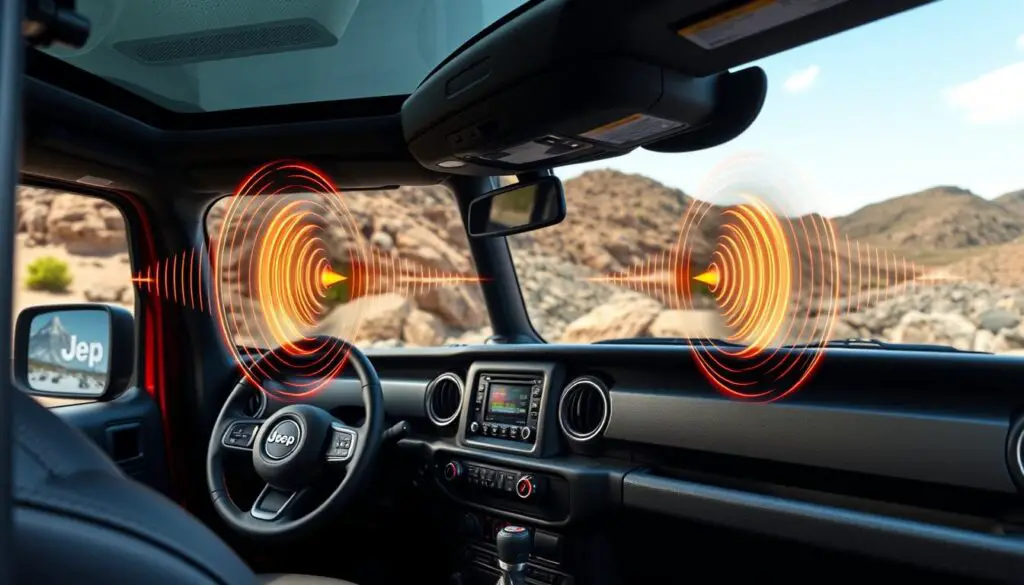
The Jeep Gladiator’s design and removable roof panels can make it noisy, mainly at high speeds. The cabin noise is a big drawback, affecting both drivers and passengers. Reports show the interior is very loud with the soft top on, which is a major issue for those seeking quiet rides.
Engine and wind noises are common complaints, but they’re a trade-off for the truck’s off-road prowess. Upgrading to a harder top or using noise-reducing materials can help. This way, drivers can reduce distractions and enjoy a quieter ride.
Despite the noise issues, many owners find the Gladiator’s benefits outweigh the drawbacks. With the right gear and care, it can be a comfortable and fun vehicle, even at fast speeds. Knowing the potential problems helps owners take steps to lessen their impact. This way, they can still enjoy the Gladiator’s many advantages.
Visibility Issues
The Jeep Gladiator has design features that can affect the driver’s sightlines. Large pillars and a big rear cargo area can lead to blind spots. The high beltline and small rear window also make it hard to see pedestrians, cyclists, or other cars when changing lanes or reversing.
Some owners find it hard to see the road ahead because of the Gladiator’s design. The limited visibility is a drawback for drivers who want a clear view. Yet, the Gladiator’s design also adds to its ruggedness and off-road ability.
To deal with these issues, drivers can use mirrors and cameras for a better view. It’s crucial to be mindful of blind spots and take extra care when changing lanes or reversing. Knowing about the Gladiator’s visibility issues helps drivers stay safe on the road.
| Feature | Description |
|---|---|
| Large pillars | Can create blind spots and limit visibility |
| High beltline | Can make it difficult to see pedestrians or cyclists |
| Small rear window | Can limit visibility when reversing or changing lanes |
Towing Capacity Compromises
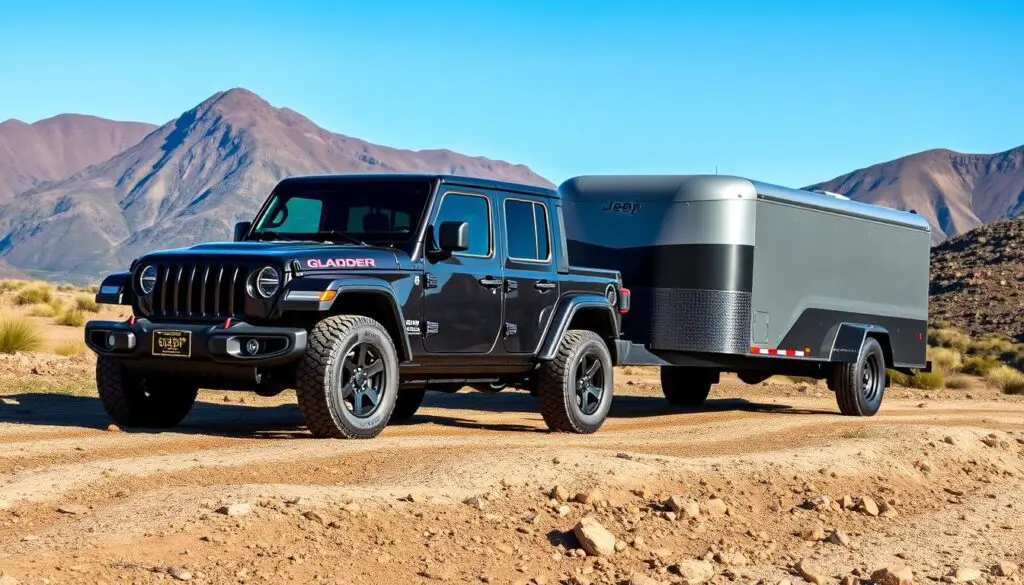
The Jeep Gladiator’s towing capacity is a big deal for those who haul heavy loads. It has a lower towing capacity than some rivals. This can be a big problem for some owners.
The Gladiator Rubicon with a 3.6L gas engine can tow up to 7,650 pounds. But, the diesel engine version can only tow 6,000 pounds. These limits might be a big issue for those who need to tow heavy loads.
Comparison to Rivals
Trucks like the Toyota Tacoma and Ford Ranger have similar towing capacities to the Gladiator. But, full-size trucks like the F-150 and Silverado can tow much more. This makes it hard for the Gladiator to compete.
Real-World Towing Experiences
Towing with the Gladiator can vary a lot. Towing in flat areas is different from mountainous regions. High elevations can reduce power by about 30%.
Also, towing too much can affect the Gladiator’s stability and safety. It’s important to think about these issues before buying.
Maintenance and Repair Costs
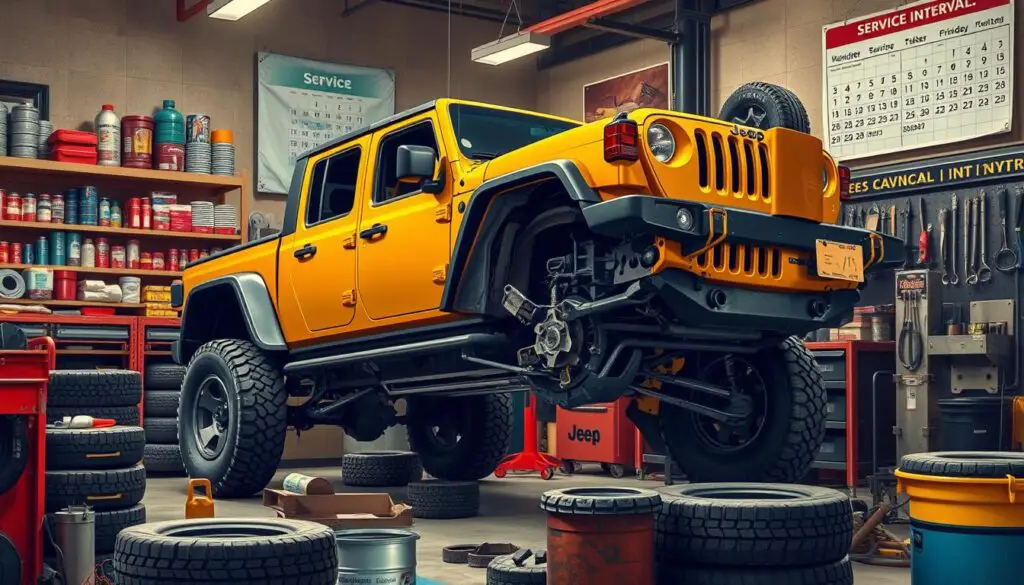
Thinking about buying a Jeep Gladiator? Remember, maintenance and repair costs are a big deal. Owners often find these costs higher than usual. Over 10 years, you might spend about $12,478 on repairs, which is $2,373 more than other trucks.
There’s a 35.84% chance of needing a major repair in the first 10 years. This is 7.10% worse than other trucks. In the first five years, you could spend around $3,912 on repairs. There’s a 6% chance of a major repair, which is 36% better than similar trucks.
Long-Term Ownership Expenses
Let’s look at the repair costs over time:
- Year 1: 3.70% with annual costs of $498
- Year 2: 6.13% with annual costs of $587
- Year 3: 6.88% with annual costs of $728
- Year 4: 12.15% with annual costs of $955
- Year 5: 17.41% with annual costs of $1,143
These costs can really add up. It’s important to think about the Jeep Gladiator’s negatives and how they affect your budget.
Availability of Parts
Another thing to consider is part availability. Luckily, many owners find parts easy to get. Keeping up with maintenance and repairs can help avoid big problems later.
Resale Value Considerations
The Jeep Gladiator has some downsides, like its resale value. It can lose value fast, with some models dropping to 77% of their original price after five years. For example, a Gladiator starting at $39,620 might be worth about $30,507 after five years.
Despite this, the Jeep Gladiator holds its value well in some cases. The 2021, 2022, and 2023 models are known for their strong resale value. But, the 2020 model is seen as the least valuable due to many complaints and recalls.
When thinking about buying a Jeep Gladiator, it’s important to consider its potential for depreciation and maintenance costs. The first ten years of ownership could cost $11,803 in maintenance, which is more than average. Knowing these points can help buyers make a better choice and deal with some of the Gladiator’s issues.
FAQ
What are the negatives of a Jeep Gladiator?
What are the drawbacks of the Jeep Gladiator’s fuel efficiency?
What are the issues with the Jeep Gladiator’s purchase price?
What are the problems with the Jeep Gladiator’s ride quality?
What are the disadvantages of the Jeep Gladiator’s interior space?
What are the drawbacks of the Jeep Gladiator’s noise levels in the cabin?
What are the issues with the Jeep Gladiator’s visibility?
What are the compromises of the Jeep Gladiator’s towing capacity?
What are the long-term ownership expenses of the Jeep Gladiator?
What are the resale value considerations of the Jeep Gladiator?

Hello there, this is Thomas Byrd. I am a professional car mechanic who leads a team of junior mechanics in a repair and restoration shop. In the beginning, I used to work for a jeep service center as a basic worker. From there I keep learning, changed my job 2 times and now I am a professional who leads a group of mechanics. Though a have expertise in the jeep, I know very well about all types of cars. To share my knowledge and skills with others I have created this blog website. Whenever I get free time from work I give my time to my blog.
